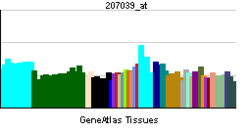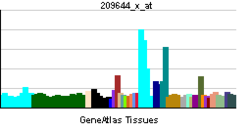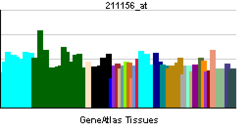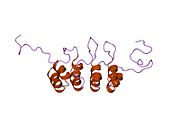- p16 (gene)
-
Cyclin-dependent kinase inhibitor 2A, (CDKN2A, p16Ink4A) also known as multiple tumor suppressor 1 (MTS-1), is a tumor suppressor protein, that in humans is encoded by the CDKN2A gene.[1][2][3] P16 plays an important role in regulating the cell cycle, and mutations in p16 increase the risk of developing a variety of cancers, notably melanoma.
Contents
Function
This gene generates several transcript variants which differ in their first exons. At least three alternatively-spliced variants encoding distinct proteins have been reported, two of which encode structurally related isoforms known to function as inhibitors of CDK4 kinase. The remaining transcript includes an alternate first exon located 20 Kb upstream of the remainder of the gene; this transcript contains an alternate open reading frame (ARF) that specifies a protein which is structurally unrelated to the products of the other variants. This ARF product functions as a stabilizer of the tumor suppressor protein p53 as it can interact with, and sequester, MDM2, a protein responsible for the degradation of p53.[4] In spite of the structural and functional differences, the CDK inhibitor isoforms and the ARF product encoded by this gene, through the regulatory roles of CDK4 and p53 in cell cycle G1 progression, share a common functionality in cell cycle G1 control. This gene is frequently mutated or deleted in a wide variety of tumors, and is known to be an important tumor suppressor gene.[1]
Increased expression of the p16 gene as organisms age reduces the proliferation of stem cells.[5] This reduction in the division and production of stem cells protects against cancer while increasing the risks associated with cellular senescence.
Clinical significance
Mutations in the CDKN2A gene are associated with increased risk of a wide range of cancers and alterations of the gene are frequently seen in cancer cell lines.[6][7] Examples include:
Pancreatic adenocarcinoma is often associated with mutations in the CDKN2A gene.[8][9][10]
Homozygous deletion of p16 are frequently found in esophageal cancer and gastric cancer cell lines.[11]
Concentrations of p16INK4a increase dramatically as tissue ages. Therefore p16INK4a could potentially be used as a blood test that measures how fast the body's tissues are aging at a molecular level.[12]
Interactions
P16 (gene) has been shown to interact with SERTAD1,[13][14] CCNG1,[15] Death associated protein 6,[16] P53,[17][18][19] E4F1,[18] Cyclin-dependent kinase 4,[13][14][20][21][22][23] Cyclin-dependent kinase 6,[21][24][25] Mdm2,[16][17][19][26][27] RPL11[17] and PPP1R9B.[28]
References
- ^ a b "Entrez Gene: CDKN2A cyclin-dependent kinase inhibitor 2A (melanoma, p16, inhibits CDK4)". http://www.ncbi.nlm.nih.gov/sites/entrez?Db=gene&Cmd=ShowDetailView&TermToSearch=1029.
- ^ Nobori T, Miura K, Wu DJ, Lois A, Takabayashi K, Carson DA (April 1994). "Deletions of the cyclin-dependent kinase-4 inhibitor gene in multiple human cancers". Nature 368 (6473): 753–6. doi:10.1038/368753a0. PMID 8152487.
- ^ Stone S, Jiang P, Dayananth P, Tavtigian SV, Katcher H, Parry D, Peters G, Kamb A (July 1995). "Complex structure and regulation of the P16 (MTS1) locus". Cancer Res. 55 (14): 2988–94. PMID 7606716. http://cancerres.aacrjournals.org/cgi/content/abstract/55/14/2988.
- ^ "Molecular biology of cancer", Oxford University Press, 2005, ISBN 978-0-19-926472-8, Section 5.3
- ^ Krishnamurthy J, Ramsey MR, Ligon KL, Torrice C, Koh A, Bonner-Weir S, Sharpless NE (September 2006). "p16INK4a induces an age-dependent decline in islet regenerative potential". Nature 443 (7110): 453–7. doi:10.1038/nature05092. PMID 16957737.
- ^ Liggett WH, Sidransky D (March 1998). "Role of the p16 tumor suppressor gene in cancer". J. Clin. Oncol. 16 (3): 1197–206. PMID 9508208. http://www.jco.org/cgi/pmidlookup?view=long&pmid=9508208.
- ^ Rocco JW, Sidransky D (March 2001). "p16(MTS-1/CDKN2/INK4a) in cancer progression". Exp. Cell Res. 264 (1): 42–55. doi:10.1006/excr.2000.5149. PMID 11237522.
- ^ Caldas C, Hahn SA, da Costa LT, Redston MS, Schutte M, Seymour AB, Weinstein CL, Hruban RH et al. (September 1994). "Frequent somatic mutations and homozygous deletions of the p16 (MTS1) gene in pancreatic adenocarcinoma". Nat. Genet. 8 (1): 27–32. doi:10.1038/ng0994-27. PMID 7726912.
- ^ Bartsch D, Shevlin DW, Tung WS, Kisker O, Wells SA, Goodfellow PJ (November 1995). "Frequent mutations of CDKN2 in primary pancreatic adenocarcinomas". Genes Chromosomes Cancer 14 (3): 189–95. doi:10.1002/gcc.2870140306. PMID 8589035.
- ^ Liu L, Lassam NJ, Slingerland JM, Bailey D, Cole D, Jenkins R, Hogg D (July 1995). "Germline p16INK4A mutation and protein dysfunction in a family with inherited melanoma". Oncogene 11 (2): 405–12. PMID 7624155.
- ^ Igaki H, Sasaki H, Kishi T, Sakamoto H, Tachimori Y, Kato H, Watanabe H, Sugimura T et al. (September 1994). "Highly frequent homozygous deletion of the p16 gene in esophageal cancer cell lines". Biochem. Biophys. Res. Commun. 203 (2): 1090–5. doi:10.1006/bbrc.1994.2294. PMID 8093026.
- ^ Liu Y, Sanoff HK, Cho H, Burd CE, Torrice C, Ibrahim JG, Thomas NE, Sharpless NE (May 2009). "Expression of p16INK4a in peripheral blood T-cells is a biomarker of human aging". Aging Cell 8 (4): 439–48. doi:10.1111/j.1474-9726.2009.00489.x. PMC 2752333. PMID 19485966. http://www.pubmedcentral.nih.gov/articlerender.fcgi?tool=pmcentrez&artid=2752333. [BBC News Lay summary] – Hope for test to measure ageing.
- ^ a b Li, Junan, , Tsai Ming-Daw, Muscarella Peter, Tsai, Ming-Daw, Muscarella, Peter (Apr. 2004). "The nuclear protein p34SEI-1 regulates the kinase activity of cyclin-dependent kinase 4 in a concentration-dependent manner". Biochemistry (United States) 43 (14): 4394–9. doi:10.1021/bi035601s. ISSN 0006-2960. PMID 15065884.
- ^ a b Sugimoto, M, Ohtani N, Hampson L, Hampson I N, Shimamoto A, Furuichi Y, Okumura K, Niwa S et al. (Nov. 1999). "Regulation of CDK4 activity by a novel CDK4-binding protein, p34SEI-1". Genes Dev. (UNITED STATES) 13 (22): 3027–33. doi:10.1101/gad.13.22.3027. ISSN 0890-9369. PMC 317153. PMID 10580009. http://www.pubmedcentral.nih.gov/articlerender.fcgi?tool=pmcentrez&artid=317153.
- ^ Zhao, Lili, Winckler Sarah, Korgaonkar Chandrashekhar, Tompkins Van, Horne Mary C, , Quelle Dawn E, Quelle, DE (Jan. 2003). "Cyclin G1 has growth inhibitory activity linked to the ARF-Mdm2-p53 and pRb tumor suppressor pathways". Mol. Cancer Res. (United States) 1 (3): 195–206. ISSN 1541-7786. PMID 12556559.
- ^ a b Ivanchuk, Stacey M, , Rutka James T, Rutka, James T. (Jun. 2008). "p14ARF interacts with DAXX: effects on HDM2 and p53". Cell Cycle (United States) 7 (12): 1836–50. doi:10.4161/cc.7.12.6025. PMID 18583933.
- ^ a b c Zhang, Yanping, Bhat Krishna, Jin Aiwen, Allio Theresa, Burkhart William A, , Xiong Yue, Xiong, Y. (Dec. 2003). "Ribosomal Protein L11 Negatively Regulates Oncoprotein MDM2 and Mediates a p53-Dependent Ribosomal-Stress Checkpoint Pathway". Mol. Cell. Biol. (United States) 23 (23): 8902–12. doi:10.1128/MCB.23.23.8902-8912.2003. ISSN 0270-7306. PMC 262682. PMID 14612427. http://www.pubmedcentral.nih.gov/articlerender.fcgi?tool=pmcentrez&artid=262682.
- ^ a b Rizos, Helen, Badhwar Prerna, Woodruff Sarah, Becker Therese M, Rooney Robert J, , Kefford Richard F, Kefford, RF (Feb. 2003). "Association of p14ARF with the p120E4F transcriptional repressor enhances cell cycle inhibition". J. Biol. Chem. (United States) 278 (7): 4981–9. doi:10.1074/jbc.M210978200. ISSN 0021-9258. PMID 12446718.
- ^ a b Zhang, Y, , Yarbrough W G, Yarbrough, Wendell G (Mar. 1998). "ARF promotes MDM2 degradation and stabilizes p53: ARF-INK4a locus deletion impairs both the Rb and p53 tumor suppression pathways". Cell (UNITED STATES) 92 (6): 725–34. doi:10.1016/S0092-8674(00)81401-4. ISSN 0092-8674. PMID 9529249.
- ^ Ewing, Rob M, Elisma Fred, Li Hongyan, Taylor Paul, Climie Shane, McBroom-Cerajewski Linda, Robinson Mark D, Connor Liam et al. (2007). "Large-scale mapping of human protein–protein interactions by mass spectrometry". Mol. Syst. Biol. (England) 3 (1): 89. doi:10.1038/msb4100134. PMC 1847948. PMID 17353931. http://www.pubmedcentral.nih.gov/articlerender.fcgi?tool=pmcentrez&artid=1847948.
- ^ a b Fåhraeus, R, Ball K L, Laín S, , Lane D P, Lane, David P. (Jan. 1996). "Inhibition of pRb phosphorylation and cell-cycle progression by a 20-residue peptide derived from p16CDKN2/INK4A". Curr. Biol. (ENGLAND) 6 (1): 84–91. doi:10.1016/S0960-9822(02)00425-6. ISSN 0960-9822. PMID 8805225.
- ^ Serrano, M, , Beach D, Beach, David (Dec. 1993). "A new regulatory motif in cell-cycle control causing specific inhibition of cyclin D/CDK4". Nature (ENGLAND) 366 (6456): 704–7. doi:10.1038/366704a0. ISSN 0028-0836. PMID 8259215.
- ^ Coleman, K G, Morrissey D, Mulheron J, Sedman S A, Brinkley P, Price S, , Webster K R, Webster, KR (Jul. 1997). "Identification of CDK4 sequences involved in cyclin D1 and p16 binding". J. Biol. Chem. (UNITED STATES) 272 (30): 18869–74. doi:10.1074/jbc.272.30.18869. ISSN 0021-9258. PMID 9228064.
- ^ Russo, A A, Lee J O, Jeffrey P D, , Pavletich N P, Jeffrey, Philip D. (Sep. 1998). "Structural basis for inhibition of the cyclin-dependent kinase Cdk6 by the tumour suppressor p16INK4a". Nature (ENGLAND) 395 (6699): 237–43. doi:10.1038/26155. ISSN 0028-0836. PMID 9751050.
- ^ Kaldis, P, Tong L, Mäkelä T P, , Solomon M J, Solomon, MJ (Dec. 2001). "CAK-independent Activation of CDK6 by a Viral Cyclin". Mol. Biol. Cell (United States) 12 (12): 3987–99. ISSN 1059-1524. PMC 60770. PMID 11739795. http://www.pubmedcentral.nih.gov/articlerender.fcgi?tool=pmcentrez&artid=60770.
- ^ Clark, Paula A, , Peters Gordon, Peters, Gordon (Jul. 2002). "Multiple interacting domains contribute to p14ARF mediated inhibition of MDM2". Oncogene (England) 21 (29): 4498–507. doi:10.1038/sj.onc.1205558. ISSN 0950-9232. PMID 12085228.
- ^ Pomerantz, J, Liégeois N J, Silverman A, Alland L, Chin L, Potes J, Chen K, Orlow I et al. (Mar. 1998). "The Ink4a tumor suppressor gene product, p19Arf, interacts with MDM2 and neutralizes MDM2's inhibition of p53". Cell (UNITED STATES) 92 (6): 713–23. doi:10.1016/S0092-8674(00)81400-2. ISSN 0092-8674. PMID 9529248.
- ^ Vivo, M, Sansone F, Calabrò V, Parisi T, Borrelli L, Saviozzi S, , La Mantia G, La Mantia, G (Apr. 2001). "The human tumor suppressor arf interacts with spinophilin/neurabin II, a type 1 protein-phosphatase-binding protein". J. Biol. Chem. (United States) 276 (17): 14161–9. doi:10.1074/jbc.M006845200. ISSN 0021-9258. PMID 11278317.
Further reading
- Smith-Sørensen B, Hovig E (1996). "CDKN2A (p16INK4A) somatic and germline mutations". Hum. Mutat. 7 (4): 294–303. doi:10.1002/(SICI)1098-1004(1996)7:4<294::AID-HUMU2>3.0.CO;2-9. PMID 8723678.
- Dracopoli NC, Fountain JW (1996). "CDKN2 mutations in melanoma". Cancer Surv. 26: 115–32. PMID 8783570.
- Akita H (2003). "[Prognostic importance of altered expression of cell cycle regulators in lung cancer]". Nippon Rinsho 60 Suppl 5: 267–71. PMID 12101670.
- Kusy S, Larsen CJ, Roche J (2005). "p14ARF, p15INK4b and p16INK4a methylation status in chronic myelogenous leukemia". Leuk. Lymphoma 45 (10): 1989–94. doi:10.1080/10428190410001714025. PMID 15370242.
- Gjerset RA (2007). "DNA damage, p14ARF, nucleophosmin (NPM/B23), and cancer". J. Mol. Histol. 37 (5–7): 239–51. doi:10.1007/s10735-006-9040-y. PMID 16855788.
- Yildiz IZ, Usubütün A, Firat P et al. (2007). "Efficiency of immunohistochemical p16 expression and HPV typing in cervical squamous intraepithelial lesion grading and review of the p16 literature". Pathol. Res. Pract. 203 (6): 445–9. doi:10.1016/j.prp.2007.03.010. PMID 17543474.
External links
PDB gallery 1a5e: SOLUTION NMR STRUCTURE OF TUMOR SUPPRESSOR P16INK4A, 18 STRUCTURES1bi7: MECHANISM OF G1 CYCLIN DEPENDENT KINASE INHIBITION FROM THE STRUCTURE OF THE CDK6-P16INK4A TUMOR SUPPRESSOR COMPLEX1dc2: SOLUTION NMR STRUCTURE OF TUMOR SUPPRESSOR P16INK4A, 20 STRUCTURES2a5e: SOLUTION NMR STRUCTURE OF TUMOR SUPPRESSOR P16INK4A, RESTRAINED MINIMIZED MEAN STRUCTURECell cycle proteins Cyclin CDK CDK inhibitor P53 p63 p73 family Phases and
checkpointsOther cellular phasesNeoplasm: Tumor suppressor genes/proteins and Oncogenes/Proto-oncogenes Ligand Receptor TSP: CDH1TSP: PTCH1TSP: TGF beta receptor 2Intracellular signaling P+Ps ONCO: Beta-catenin · TSP: APCHippo signaling pathwayOther/unknownNucleus TSP: VHL · ONCO: CBL - MDM2Mitochondria Other/ungrouped M: NEO
tsoc, mrkr
tumr, epon, para
drug (L1i/1e/V03)
Categories:- Human proteins
- Tumor suppressor genes
Wikimedia Foundation. 2010.








